Importance of National Culture in Branding Products in Nepal
VerifiedAdded on 2023/04/21
|103
|26377
|198
Dissertation
AI Summary
This dissertation investigates the crucial role of national culture in product branding within Nepal. The research explores the impact of cultural factors, including customs, beliefs, and societal norms, on branding strategies. The study utilizes a descriptive design with a survey research strategy, collecting primary data from 50 participants using a simple random probability sampling technique. The dissertation examines the challenges faced by businesses in Nepal due to cultural differences, such as increased secular beliefs and varying brand recognition. Through correlation and regression analysis, the study reveals a strong relationship between national culture and product branding, highlighting the importance of understanding and adapting to local cultural nuances. The findings emphasize the need for businesses to consider cultural heritage to achieve successful branding, offering recommendations for mitigating cultural challenges and enhancing marketing effectiveness in the Nepalese market. The dissertation includes a comprehensive literature review, detailed methodology, and analysis of data to support its conclusions.
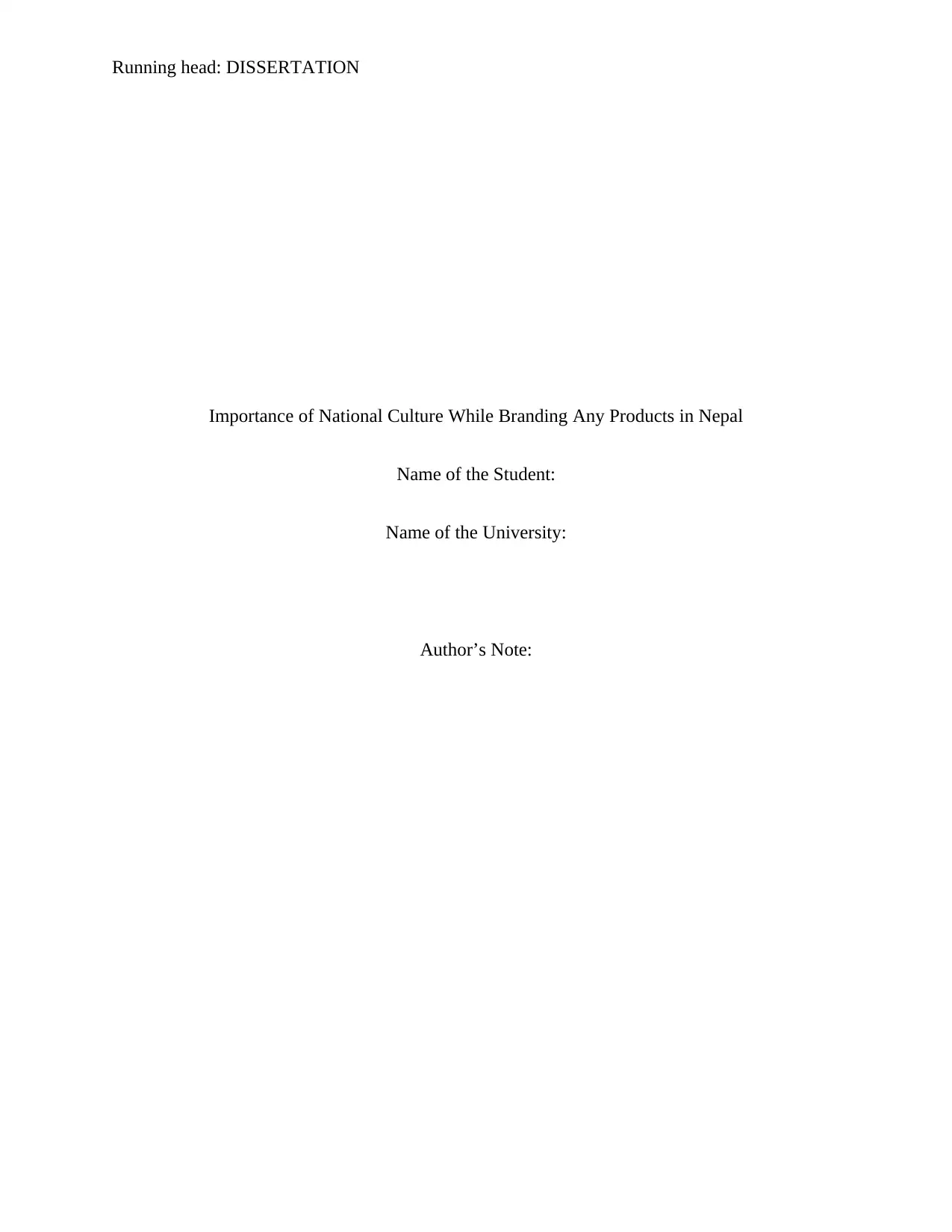
Running head: DISSERTATION
Importance of National Culture While Branding Any Products in Nepal
Name of the Student:
Name of the University:
Author’s Note:
Importance of National Culture While Branding Any Products in Nepal
Name of the Student:
Name of the University:
Author’s Note:
Paraphrase This Document
Need a fresh take? Get an instant paraphrase of this document with our AI Paraphraser
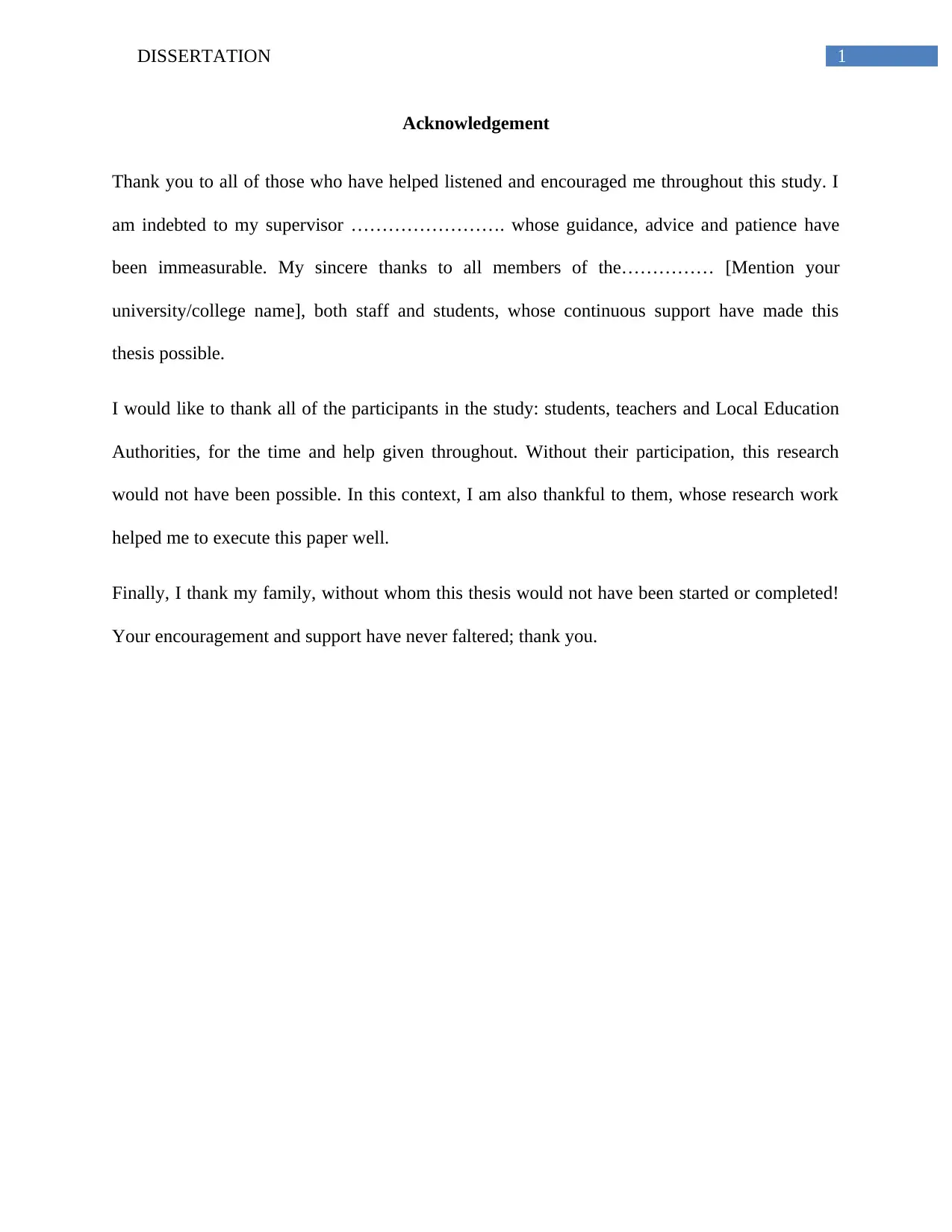
1DISSERTATION
Acknowledgement
Thank you to all of those who have helped listened and encouraged me throughout this study. I
am indebted to my supervisor ……………………. whose guidance, advice and patience have
been immeasurable. My sincere thanks to all members of the…………… [Mention your
university/college name], both staff and students, whose continuous support have made this
thesis possible.
I would like to thank all of the participants in the study: students, teachers and Local Education
Authorities, for the time and help given throughout. Without their participation, this research
would not have been possible. In this context, I am also thankful to them, whose research work
helped me to execute this paper well.
Finally, I thank my family, without whom this thesis would not have been started or completed!
Your encouragement and support have never faltered; thank you.
Acknowledgement
Thank you to all of those who have helped listened and encouraged me throughout this study. I
am indebted to my supervisor ……………………. whose guidance, advice and patience have
been immeasurable. My sincere thanks to all members of the…………… [Mention your
university/college name], both staff and students, whose continuous support have made this
thesis possible.
I would like to thank all of the participants in the study: students, teachers and Local Education
Authorities, for the time and help given throughout. Without their participation, this research
would not have been possible. In this context, I am also thankful to them, whose research work
helped me to execute this paper well.
Finally, I thank my family, without whom this thesis would not have been started or completed!
Your encouragement and support have never faltered; thank you.
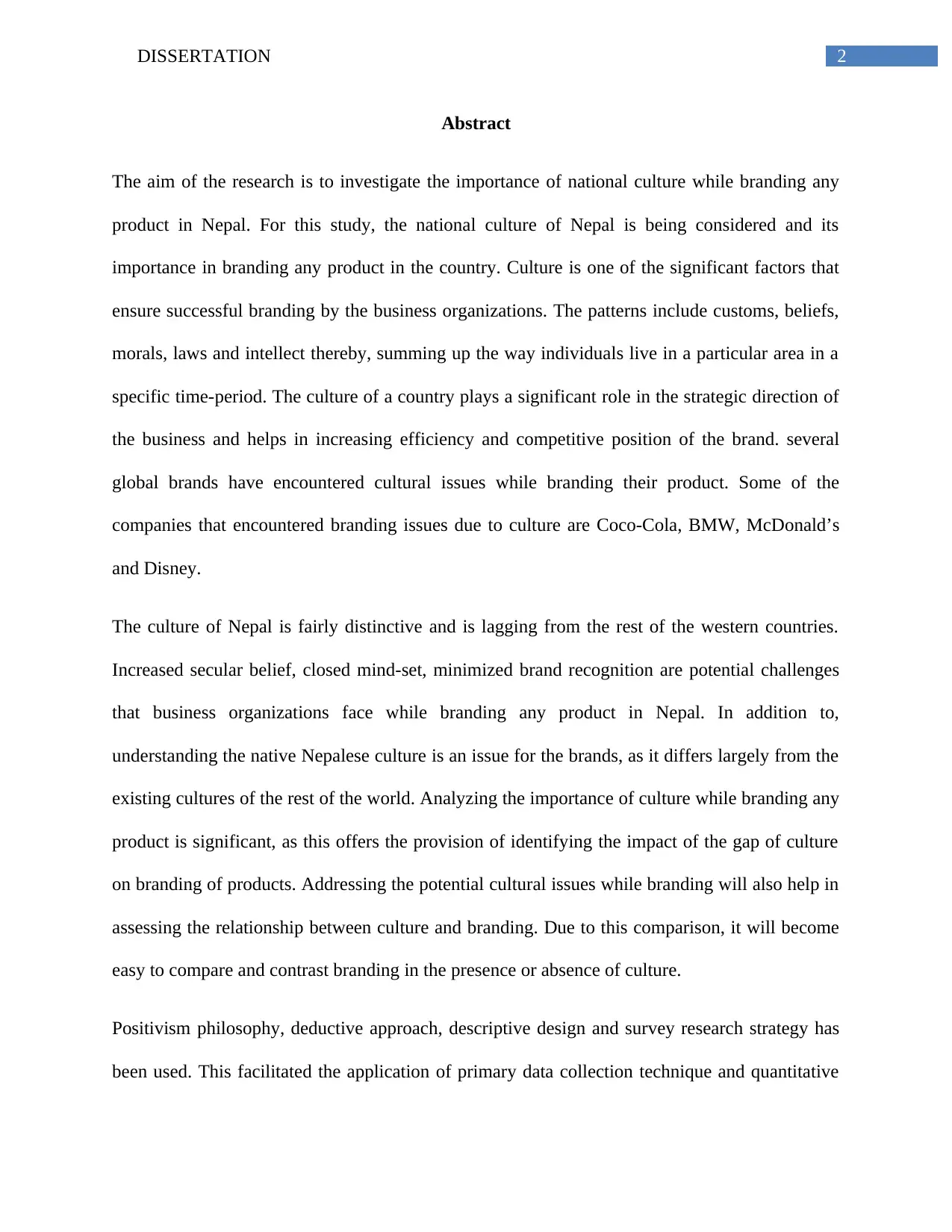
2DISSERTATION
Abstract
The aim of the research is to investigate the importance of national culture while branding any
product in Nepal. For this study, the national culture of Nepal is being considered and its
importance in branding any product in the country. Culture is one of the significant factors that
ensure successful branding by the business organizations. The patterns include customs, beliefs,
morals, laws and intellect thereby, summing up the way individuals live in a particular area in a
specific time-period. The culture of a country plays a significant role in the strategic direction of
the business and helps in increasing efficiency and competitive position of the brand. several
global brands have encountered cultural issues while branding their product. Some of the
companies that encountered branding issues due to culture are Coco-Cola, BMW, McDonald’s
and Disney.
The culture of Nepal is fairly distinctive and is lagging from the rest of the western countries.
Increased secular belief, closed mind-set, minimized brand recognition are potential challenges
that business organizations face while branding any product in Nepal. In addition to,
understanding the native Nepalese culture is an issue for the brands, as it differs largely from the
existing cultures of the rest of the world. Analyzing the importance of culture while branding any
product is significant, as this offers the provision of identifying the impact of the gap of culture
on branding of products. Addressing the potential cultural issues while branding will also help in
assessing the relationship between culture and branding. Due to this comparison, it will become
easy to compare and contrast branding in the presence or absence of culture.
Positivism philosophy, deductive approach, descriptive design and survey research strategy has
been used. This facilitated the application of primary data collection technique and quantitative
Abstract
The aim of the research is to investigate the importance of national culture while branding any
product in Nepal. For this study, the national culture of Nepal is being considered and its
importance in branding any product in the country. Culture is one of the significant factors that
ensure successful branding by the business organizations. The patterns include customs, beliefs,
morals, laws and intellect thereby, summing up the way individuals live in a particular area in a
specific time-period. The culture of a country plays a significant role in the strategic direction of
the business and helps in increasing efficiency and competitive position of the brand. several
global brands have encountered cultural issues while branding their product. Some of the
companies that encountered branding issues due to culture are Coco-Cola, BMW, McDonald’s
and Disney.
The culture of Nepal is fairly distinctive and is lagging from the rest of the western countries.
Increased secular belief, closed mind-set, minimized brand recognition are potential challenges
that business organizations face while branding any product in Nepal. In addition to,
understanding the native Nepalese culture is an issue for the brands, as it differs largely from the
existing cultures of the rest of the world. Analyzing the importance of culture while branding any
product is significant, as this offers the provision of identifying the impact of the gap of culture
on branding of products. Addressing the potential cultural issues while branding will also help in
assessing the relationship between culture and branding. Due to this comparison, it will become
easy to compare and contrast branding in the presence or absence of culture.
Positivism philosophy, deductive approach, descriptive design and survey research strategy has
been used. This facilitated the application of primary data collection technique and quantitative
⊘ This is a preview!⊘
Do you want full access?
Subscribe today to unlock all pages.

Trusted by 1+ million students worldwide

3DISSERTATION
data analysis technique that is analyzed using co-relation and regression techniques using SPSS
software. In accordance with the survey research strategy, 50 participants are selected sing
simple random probability sampling technique that would help in understanding the significance
of national culture while branding any product in Nepal.
The results obtained from the data analysis indicates that the significant value has come to .000,
which states that the null hypothesis has been rejected and the alternate hypothesis has been
accepted in this case as well. As a result, it can be inferred that there is a strong relationship
between the national cultures that is present in the Nepal market with respect to the product
branding.
data analysis technique that is analyzed using co-relation and regression techniques using SPSS
software. In accordance with the survey research strategy, 50 participants are selected sing
simple random probability sampling technique that would help in understanding the significance
of national culture while branding any product in Nepal.
The results obtained from the data analysis indicates that the significant value has come to .000,
which states that the null hypothesis has been rejected and the alternate hypothesis has been
accepted in this case as well. As a result, it can be inferred that there is a strong relationship
between the national cultures that is present in the Nepal market with respect to the product
branding.
Paraphrase This Document
Need a fresh take? Get an instant paraphrase of this document with our AI Paraphraser

4DISSERTATION
Table of Contents
Chapter 1: Introduction....................................................................................................................9
1.0 Overview...........................................................................................................................9
1.1 Problem statement...............................................................................................................11
1.2 Research aim........................................................................................................................12
1.3 Research objectives.............................................................................................................12
1.4 Research questions...............................................................................................................13
1.5 Research hypothesis.............................................................................................................13
1.6 Research rationale................................................................................................................13
1.7 Structure of the dissertation.................................................................................................14
1.8 Summary..............................................................................................................................16
Chapter 2: Literature review..........................................................................................................17
2.0 Overview..............................................................................................................................17
2.1 Conceptual framework.........................................................................................................17
2.2 Concept of culture................................................................................................................18
2.3 Factors affecting culture......................................................................................................18
2.3.1 Religious beliefs...........................................................................................................19
2.3.2 Society..........................................................................................................................19
2.3.3 Language.......................................................................................................................20
Table of Contents
Chapter 1: Introduction....................................................................................................................9
1.0 Overview...........................................................................................................................9
1.1 Problem statement...............................................................................................................11
1.2 Research aim........................................................................................................................12
1.3 Research objectives.............................................................................................................12
1.4 Research questions...............................................................................................................13
1.5 Research hypothesis.............................................................................................................13
1.6 Research rationale................................................................................................................13
1.7 Structure of the dissertation.................................................................................................14
1.8 Summary..............................................................................................................................16
Chapter 2: Literature review..........................................................................................................17
2.0 Overview..............................................................................................................................17
2.1 Conceptual framework.........................................................................................................17
2.2 Concept of culture................................................................................................................18
2.3 Factors affecting culture......................................................................................................18
2.3.1 Religious beliefs...........................................................................................................19
2.3.2 Society..........................................................................................................................19
2.3.3 Language.......................................................................................................................20
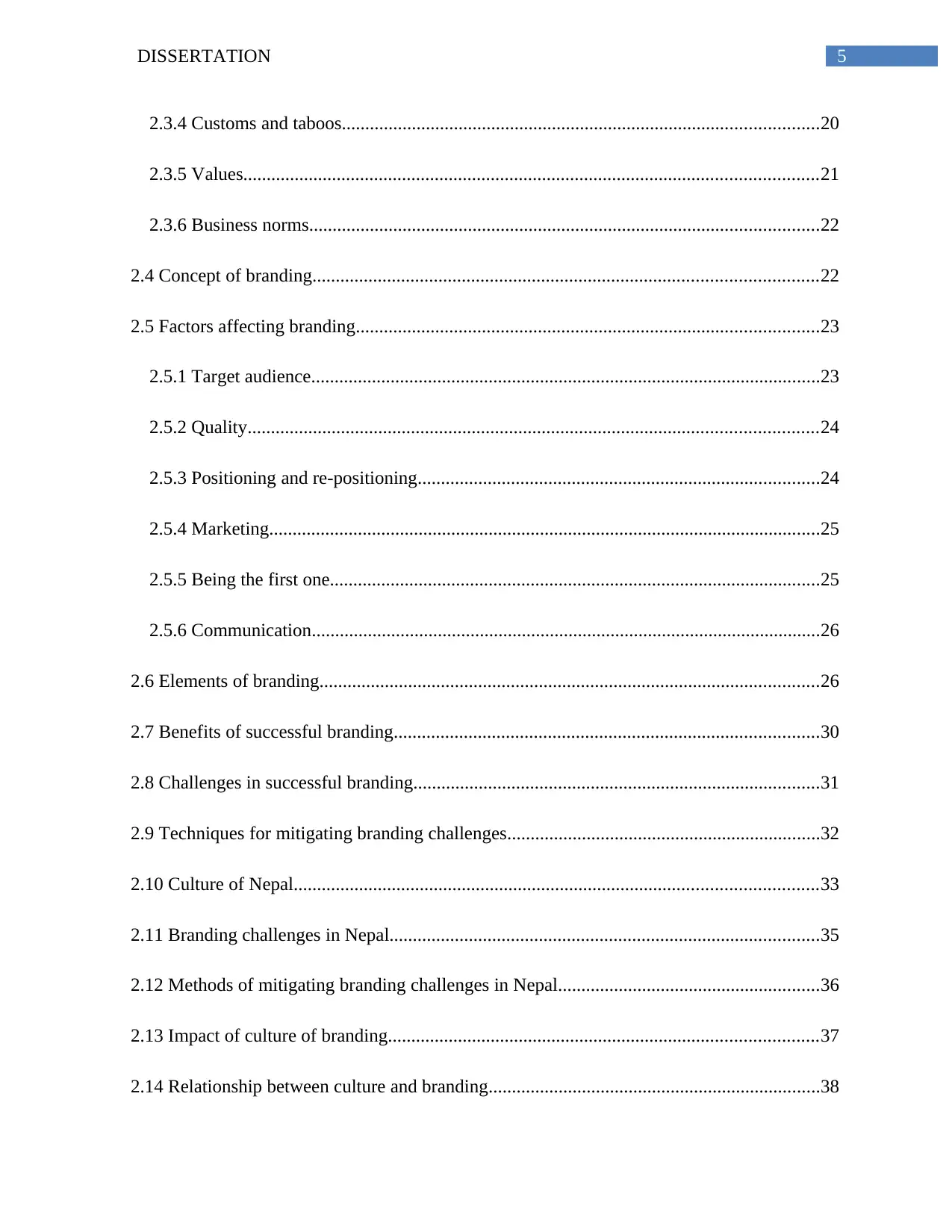
5DISSERTATION
2.3.4 Customs and taboos......................................................................................................20
2.3.5 Values...........................................................................................................................21
2.3.6 Business norms.............................................................................................................22
2.4 Concept of branding............................................................................................................22
2.5 Factors affecting branding...................................................................................................23
2.5.1 Target audience.............................................................................................................23
2.5.2 Quality..........................................................................................................................24
2.5.3 Positioning and re-positioning......................................................................................24
2.5.4 Marketing......................................................................................................................25
2.5.5 Being the first one.........................................................................................................25
2.5.6 Communication.............................................................................................................26
2.6 Elements of branding...........................................................................................................26
2.7 Benefits of successful branding...........................................................................................30
2.8 Challenges in successful branding.......................................................................................31
2.9 Techniques for mitigating branding challenges...................................................................32
2.10 Culture of Nepal................................................................................................................33
2.11 Branding challenges in Nepal............................................................................................35
2.12 Methods of mitigating branding challenges in Nepal........................................................36
2.13 Impact of culture of branding............................................................................................37
2.14 Relationship between culture and branding.......................................................................38
2.3.4 Customs and taboos......................................................................................................20
2.3.5 Values...........................................................................................................................21
2.3.6 Business norms.............................................................................................................22
2.4 Concept of branding............................................................................................................22
2.5 Factors affecting branding...................................................................................................23
2.5.1 Target audience.............................................................................................................23
2.5.2 Quality..........................................................................................................................24
2.5.3 Positioning and re-positioning......................................................................................24
2.5.4 Marketing......................................................................................................................25
2.5.5 Being the first one.........................................................................................................25
2.5.6 Communication.............................................................................................................26
2.6 Elements of branding...........................................................................................................26
2.7 Benefits of successful branding...........................................................................................30
2.8 Challenges in successful branding.......................................................................................31
2.9 Techniques for mitigating branding challenges...................................................................32
2.10 Culture of Nepal................................................................................................................33
2.11 Branding challenges in Nepal............................................................................................35
2.12 Methods of mitigating branding challenges in Nepal........................................................36
2.13 Impact of culture of branding............................................................................................37
2.14 Relationship between culture and branding.......................................................................38
⊘ This is a preview!⊘
Do you want full access?
Subscribe today to unlock all pages.

Trusted by 1+ million students worldwide
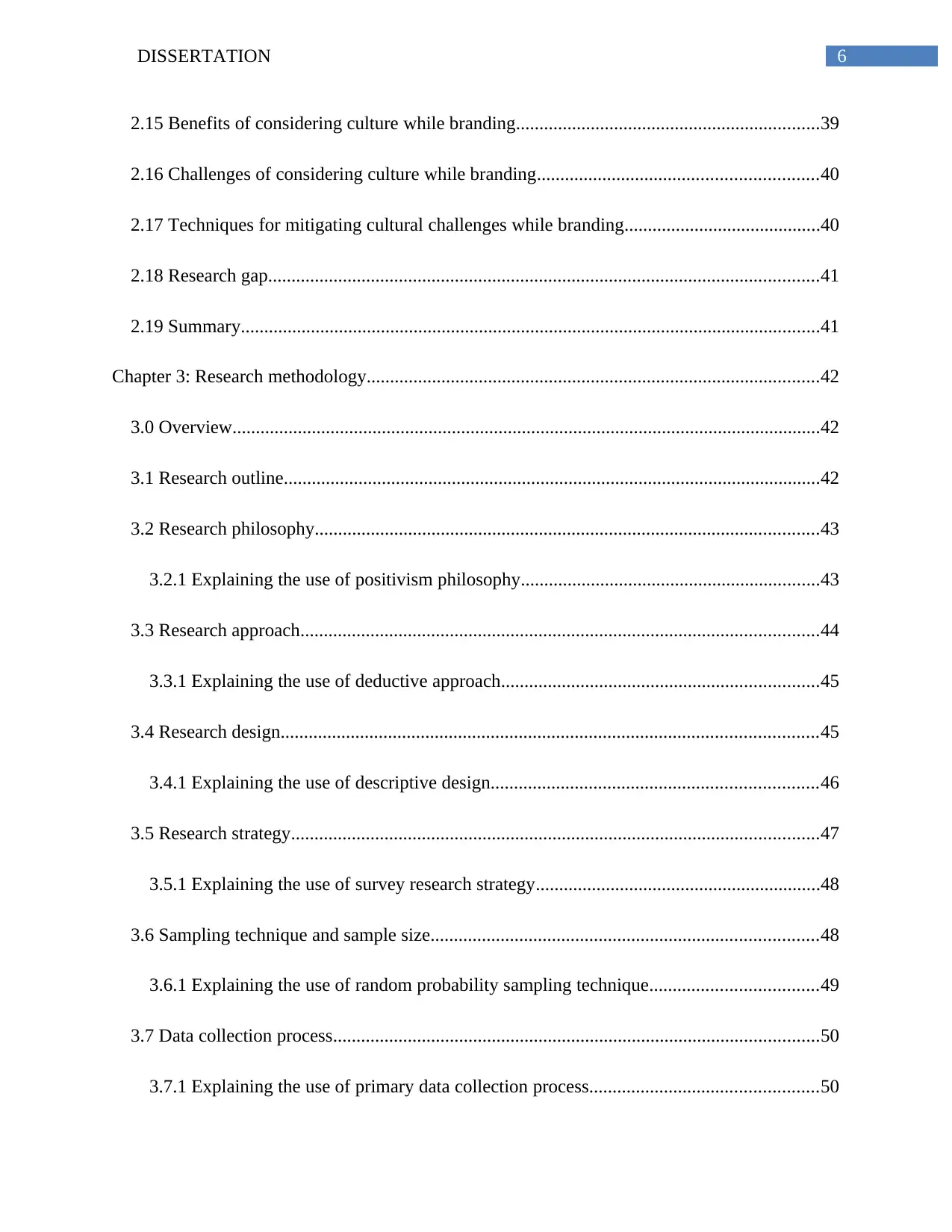
6DISSERTATION
2.15 Benefits of considering culture while branding.................................................................39
2.16 Challenges of considering culture while branding............................................................40
2.17 Techniques for mitigating cultural challenges while branding..........................................40
2.18 Research gap......................................................................................................................41
2.19 Summary............................................................................................................................41
Chapter 3: Research methodology.................................................................................................42
3.0 Overview..............................................................................................................................42
3.1 Research outline...................................................................................................................42
3.2 Research philosophy............................................................................................................43
3.2.1 Explaining the use of positivism philosophy................................................................43
3.3 Research approach...............................................................................................................44
3.3.1 Explaining the use of deductive approach....................................................................45
3.4 Research design...................................................................................................................45
3.4.1 Explaining the use of descriptive design......................................................................46
3.5 Research strategy.................................................................................................................47
3.5.1 Explaining the use of survey research strategy.............................................................48
3.6 Sampling technique and sample size...................................................................................48
3.6.1 Explaining the use of random probability sampling technique....................................49
3.7 Data collection process........................................................................................................50
3.7.1 Explaining the use of primary data collection process.................................................50
2.15 Benefits of considering culture while branding.................................................................39
2.16 Challenges of considering culture while branding............................................................40
2.17 Techniques for mitigating cultural challenges while branding..........................................40
2.18 Research gap......................................................................................................................41
2.19 Summary............................................................................................................................41
Chapter 3: Research methodology.................................................................................................42
3.0 Overview..............................................................................................................................42
3.1 Research outline...................................................................................................................42
3.2 Research philosophy............................................................................................................43
3.2.1 Explaining the use of positivism philosophy................................................................43
3.3 Research approach...............................................................................................................44
3.3.1 Explaining the use of deductive approach....................................................................45
3.4 Research design...................................................................................................................45
3.4.1 Explaining the use of descriptive design......................................................................46
3.5 Research strategy.................................................................................................................47
3.5.1 Explaining the use of survey research strategy.............................................................48
3.6 Sampling technique and sample size...................................................................................48
3.6.1 Explaining the use of random probability sampling technique....................................49
3.7 Data collection process........................................................................................................50
3.7.1 Explaining the use of primary data collection process.................................................50
Paraphrase This Document
Need a fresh take? Get an instant paraphrase of this document with our AI Paraphraser

7DISSERTATION
3.8 Data analysis technique.......................................................................................................51
3.8.1 Explaining the use of quantitative data analysis technique..........................................51
3.9 Ethical considerations..........................................................................................................51
3.10 Accessibility issues............................................................................................................52
3.11 Summary............................................................................................................................53
Chapter 4: Analysis and Findings..................................................................................................54
4.0 Introduction..........................................................................................................................54
4.1 Demographic factors............................................................................................................54
4.2 Inferential statistics..............................................................................................................56
4.2.1 Correlation analysis......................................................................................................56
4.2.2 Regression analysis.......................................................................................................67
4.3 Summary..............................................................................................................................69
Chapter 5: Discussions..................................................................................................................70
Chapter 6: Conclusion and recommendations...............................................................................73
6.0 Conclusion...........................................................................................................................73
6.1 Linking with objectives.......................................................................................................74
6.2 Recommendations................................................................................................................76
6.3 Future scope of the study.....................................................................................................78
References......................................................................................................................................79
Appendix 1.....................................................................................................................................94
3.8 Data analysis technique.......................................................................................................51
3.8.1 Explaining the use of quantitative data analysis technique..........................................51
3.9 Ethical considerations..........................................................................................................51
3.10 Accessibility issues............................................................................................................52
3.11 Summary............................................................................................................................53
Chapter 4: Analysis and Findings..................................................................................................54
4.0 Introduction..........................................................................................................................54
4.1 Demographic factors............................................................................................................54
4.2 Inferential statistics..............................................................................................................56
4.2.1 Correlation analysis......................................................................................................56
4.2.2 Regression analysis.......................................................................................................67
4.3 Summary..............................................................................................................................69
Chapter 5: Discussions..................................................................................................................70
Chapter 6: Conclusion and recommendations...............................................................................73
6.0 Conclusion...........................................................................................................................73
6.1 Linking with objectives.......................................................................................................74
6.2 Recommendations................................................................................................................76
6.3 Future scope of the study.....................................................................................................78
References......................................................................................................................................79
Appendix 1.....................................................................................................................................94
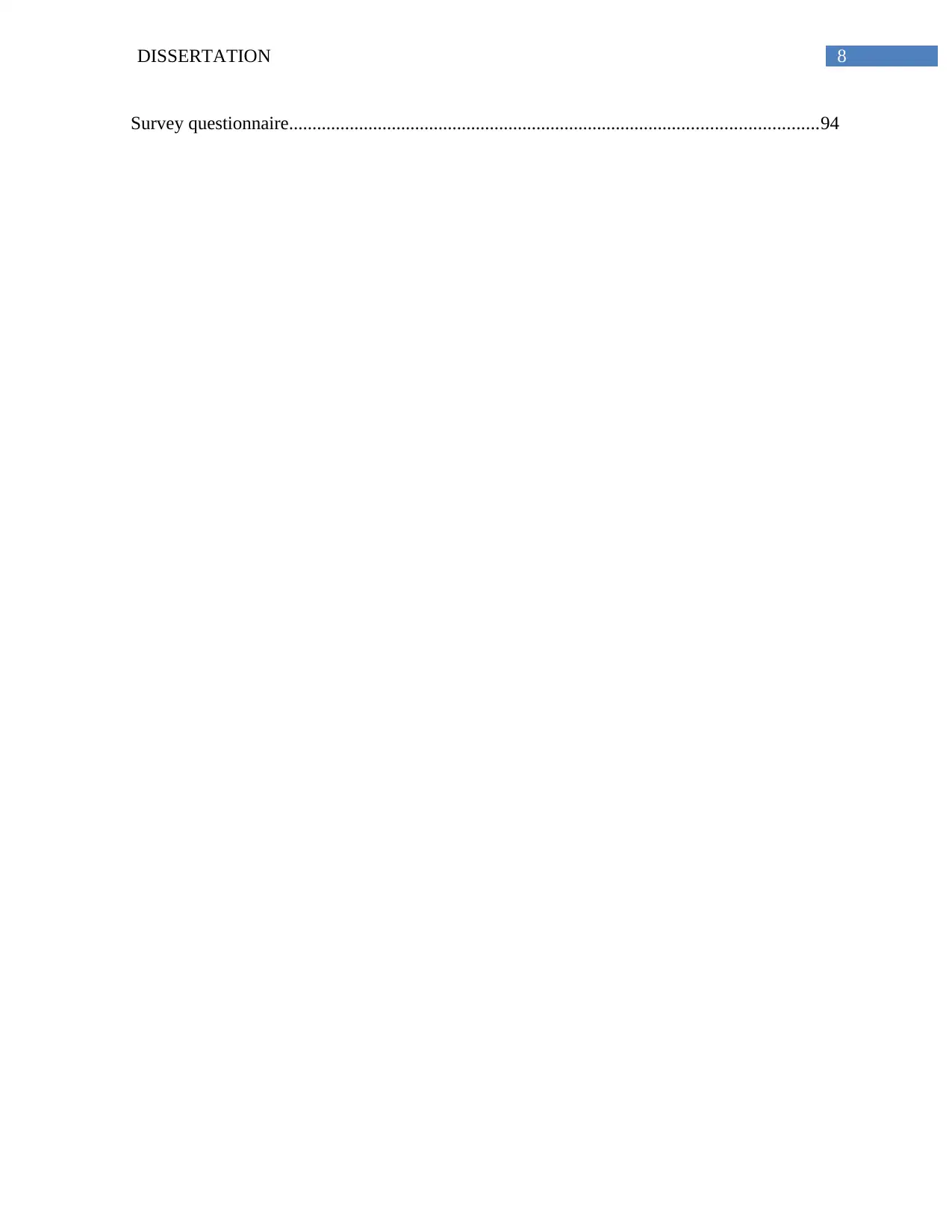
8DISSERTATION
Survey questionnaire.................................................................................................................94
Survey questionnaire.................................................................................................................94
⊘ This is a preview!⊘
Do you want full access?
Subscribe today to unlock all pages.

Trusted by 1+ million students worldwide
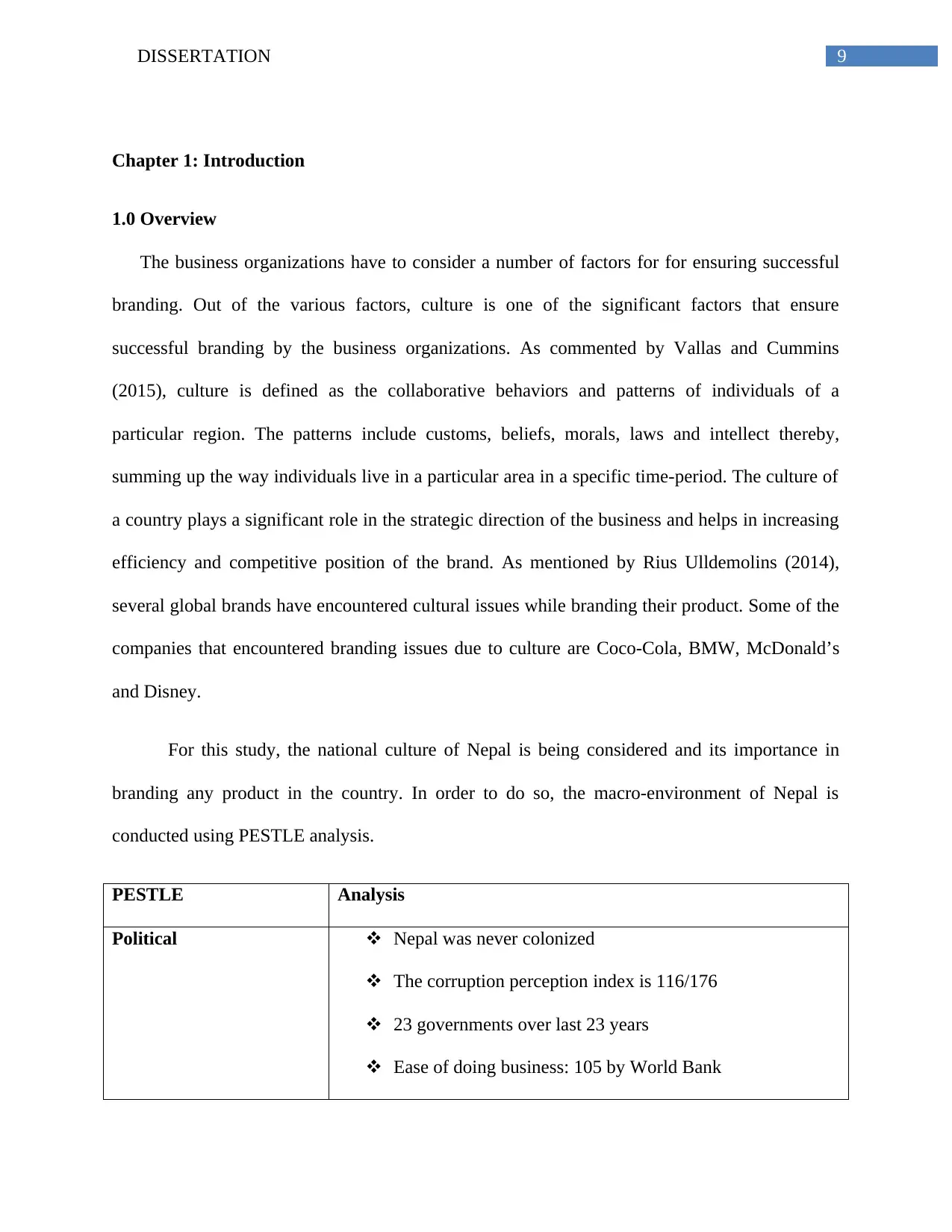
9DISSERTATION
Chapter 1: Introduction
1.0 Overview
The business organizations have to consider a number of factors for for ensuring successful
branding. Out of the various factors, culture is one of the significant factors that ensure
successful branding by the business organizations. As commented by Vallas and Cummins
(2015), culture is defined as the collaborative behaviors and patterns of individuals of a
particular region. The patterns include customs, beliefs, morals, laws and intellect thereby,
summing up the way individuals live in a particular area in a specific time-period. The culture of
a country plays a significant role in the strategic direction of the business and helps in increasing
efficiency and competitive position of the brand. As mentioned by Rius Ulldemolins (2014),
several global brands have encountered cultural issues while branding their product. Some of the
companies that encountered branding issues due to culture are Coco-Cola, BMW, McDonald’s
and Disney.
For this study, the national culture of Nepal is being considered and its importance in
branding any product in the country. In order to do so, the macro-environment of Nepal is
conducted using PESTLE analysis.
PESTLE Analysis
Political Nepal was never colonized
The corruption perception index is 116/176
23 governments over last 23 years
Ease of doing business: 105 by World Bank
Chapter 1: Introduction
1.0 Overview
The business organizations have to consider a number of factors for for ensuring successful
branding. Out of the various factors, culture is one of the significant factors that ensure
successful branding by the business organizations. As commented by Vallas and Cummins
(2015), culture is defined as the collaborative behaviors and patterns of individuals of a
particular region. The patterns include customs, beliefs, morals, laws and intellect thereby,
summing up the way individuals live in a particular area in a specific time-period. The culture of
a country plays a significant role in the strategic direction of the business and helps in increasing
efficiency and competitive position of the brand. As mentioned by Rius Ulldemolins (2014),
several global brands have encountered cultural issues while branding their product. Some of the
companies that encountered branding issues due to culture are Coco-Cola, BMW, McDonald’s
and Disney.
For this study, the national culture of Nepal is being considered and its importance in
branding any product in the country. In order to do so, the macro-environment of Nepal is
conducted using PESTLE analysis.
PESTLE Analysis
Political Nepal was never colonized
The corruption perception index is 116/176
23 governments over last 23 years
Ease of doing business: 105 by World Bank
Paraphrase This Document
Need a fresh take? Get an instant paraphrase of this document with our AI Paraphraser

10DISSERTATION
Prime Minister is the head of the government (Singh 2017)
Economic Nepal is one of the developing countries with one-quarter
of the population living under poverty.
Economic freedom score of Nepal is 54.1 thereby, making
it 133rd freest in the 2018 index.
Economic growth of Nepal is restricted due to lack of
entrepreneurial dynamism
Current GDP of Nepal is 2,447.2 crores USD (Bastola and
Sapkota 2015)
Social Religion is one of the crucial aspect in Nepal
81% Hindus, 9% Buddhist, 4.4% Muslim, 3.1% Kirat,
1.4% Christian, 0.5% others and 0.2% unspecified.
123 mother tongues are found
Nepali is the national language that is spoken by 44.6% of
the population
Staple foods are rice, lentils, pickles, vegetables and dhido
(traditional food)
Deep rooted caser system, more than 100 ethnic and caster
groups (Sapkota et al. 2014)
Technological Rich in many traditional technologies
Dominant in rural areas
Traditional technologies include pottery, paper
manufacture, medicine, food technology, textile
Prime Minister is the head of the government (Singh 2017)
Economic Nepal is one of the developing countries with one-quarter
of the population living under poverty.
Economic freedom score of Nepal is 54.1 thereby, making
it 133rd freest in the 2018 index.
Economic growth of Nepal is restricted due to lack of
entrepreneurial dynamism
Current GDP of Nepal is 2,447.2 crores USD (Bastola and
Sapkota 2015)
Social Religion is one of the crucial aspect in Nepal
81% Hindus, 9% Buddhist, 4.4% Muslim, 3.1% Kirat,
1.4% Christian, 0.5% others and 0.2% unspecified.
123 mother tongues are found
Nepali is the national language that is spoken by 44.6% of
the population
Staple foods are rice, lentils, pickles, vegetables and dhido
(traditional food)
Deep rooted caser system, more than 100 ethnic and caster
groups (Sapkota et al. 2014)
Technological Rich in many traditional technologies
Dominant in rural areas
Traditional technologies include pottery, paper
manufacture, medicine, food technology, textile

11DISSERTATION
manufacture, agriculture
Lower research and development technology, Nepal uses
only .34% of GDP in technological advancements (Amer,
Daim and Jetter 2016)
Legal Various legal Acts are in action in Nepal that includes
Partnership Act 1964, Private Firm registration Act, 1958,
Company Act 2006, Labor Act 1992, Bonus Act 1974, and
Mines and Minerals Act 1985 (Sarangi et al. 2014)
Environmental Environmental issues are continuously rising in Nepal
Pollution, over pollution, energy and species reservation,
deforestation are most concerning issues
Timber forests are threatened due to habitat degradation,
unsustainable harvesting and deforestation (Bharati et al.
2014)
From the PESTLE analysis, it can be suggested that culture is an integral part of Nepal
and the purchasing decision is highly influenced by the cultural beliefs and habits of the
population. Thus, the business organizations aiming for branding an product in Nepal needs to
consider the cultural heritage of the country for making it successful.
1.1 Problem statement
While branding any product, issues in terms of cultures are encountered that makes
branding of any product in Nepal. The culture of Nepal is fairly distinctive and is lagging from
the rest of the western countries. Thus, keeping into account the Nepalese culture, it becomes
manufacture, agriculture
Lower research and development technology, Nepal uses
only .34% of GDP in technological advancements (Amer,
Daim and Jetter 2016)
Legal Various legal Acts are in action in Nepal that includes
Partnership Act 1964, Private Firm registration Act, 1958,
Company Act 2006, Labor Act 1992, Bonus Act 1974, and
Mines and Minerals Act 1985 (Sarangi et al. 2014)
Environmental Environmental issues are continuously rising in Nepal
Pollution, over pollution, energy and species reservation,
deforestation are most concerning issues
Timber forests are threatened due to habitat degradation,
unsustainable harvesting and deforestation (Bharati et al.
2014)
From the PESTLE analysis, it can be suggested that culture is an integral part of Nepal
and the purchasing decision is highly influenced by the cultural beliefs and habits of the
population. Thus, the business organizations aiming for branding an product in Nepal needs to
consider the cultural heritage of the country for making it successful.
1.1 Problem statement
While branding any product, issues in terms of cultures are encountered that makes
branding of any product in Nepal. The culture of Nepal is fairly distinctive and is lagging from
the rest of the western countries. Thus, keeping into account the Nepalese culture, it becomes
⊘ This is a preview!⊘
Do you want full access?
Subscribe today to unlock all pages.

Trusted by 1+ million students worldwide
1 out of 103
Related Documents
Your All-in-One AI-Powered Toolkit for Academic Success.
+13062052269
info@desklib.com
Available 24*7 on WhatsApp / Email
![[object Object]](/_next/static/media/star-bottom.7253800d.svg)
Unlock your academic potential
Copyright © 2020–2025 A2Z Services. All Rights Reserved. Developed and managed by ZUCOL.





